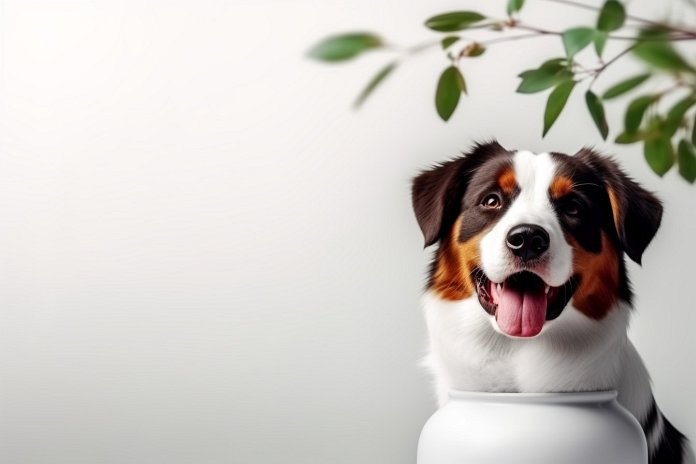
The Australian Boxherd is a hybrid breed created by crossing an Australian Shepherd and a Boxer. This breed has a medium size and a smooth fur that comes in various colors, including black and white, brown, brindle, chocolate, golden, merle, speckled, and spotted. Australian Boxherds are known for their high energy levels and are intelligent and loyal companions. They take their role as a family’s protector seriously and are self-assured and dedicated. They generally get along well with children, as they are both lively and patient. However, due to their active nature, Australian Boxherds need plenty of exercise to prevent destructive behaviors like chewing or digging caused by boredom.
Australian Boxherds commonly come in brown, brindle, chocolate, golden, merle, speckled, spotted, and white colorings.
Below, we look at Australian Boxherd dog breed, its history, personality, pros and cons of owning an Australian Boxherd, characteristics, and must-see facts. We will also examine how to care for this breed and more. Prepare for a tail-wagging adventure into the world of Australian Boxherds!
| Dog Breed | Australian Boxherd |
| Size | Large |
| Weight | 60-75 lbs (average) |
| Height | 23-25″ (average) |
| Location | Unknown |
| Ancestry | Australian Shepherd, Boxer |
| Date of Origin | Unknown |
| Group | Companion |
| Life Expectancy | 11-15 years |
| Price | $600 – $800 |
| Family | Canidae |
| Scientific Name | Canis Lupus Familiaris |
📖 Breed History
The Australian Boxherd is a hybrid breed of dog that doesn’t have a well-documented history. However, the two breeds that make up this hybrid have long and fascinating histories. The Australian Shepherd, developed in the United States, was originally bred as a herding dog. The name “Australian Shepherd” likely came about because the dog’s ancestors came from Australia, and the people who worked with these dogs named them after their origin. The breed gained popularity in the 1950s after being featured in rodeos and films. Nowadays, Australian Shepherds are employed as ranch dogs, guide dogs, therapy dogs, drug detection dogs, and in search and rescue operations.
As for the Boxer, there is evidence suggesting that it is descended from the old fighting dogs of the high valleys of Tibet. Additionally, the Boxer is believed to be related to many Bulldog breeds. For instance, the Bouldogue de Mida, found in southern France, is thought to have resulted from the Dogue de Bordeaux and shares many characteristics with the Boxer. Some sources claim that the Boxer is the result of crossing two extinct Central European breeds, the Danziger Bullenbeisser and the Brabanter Bullenbeisser. In the 1830s, German hunters attempted to create a new breed by crossing the Bullenbeissers with Mastiff-type dogs and Bulldogs. This resulted in a tough and agile dog with a streamlined body, which eventually became known as the Boxer. However, it wasn’t until around 1940 that Americans began showing interest in the Boxer breed.

🐕 Australian Boxherd Appearance
The Australian Boxherd, a cross between the Australian Shepherd and the Boxer, weighs, on average, between 55 and 66 pounds and is between 53 and 60 inches tall. The Australian Boxherd is a huge dog with a remarkable head that fits his body proportionately and a muzzle that fits his skull proportionately. The Boxherd’s waterproof, silky, thick coat is normally medium in length. The Australian Boxherd comes in a range of hues and can have or lack white markings.
| 👀 Eye Color | Varies |
| 🐽 Nose Color | N/A |
| 🐕 Coat Color | Ranges |
⚡ Fun Fact: Australian Boxherd dogs need a lot of social interaction. They desire to always be with someone or around people. This breed hates being left alone.
🐶 Traits & Temperament of Australian Boxherd
Generally speaking, the Australian Boxherd gets along nicely with kids and other animals. Dogs of the breed are lively, sociable, intelligent, patient, joyful, and generally obedient, making them easy to teach. The Australian Boxherd is well-liked by families because he is protective of his family. Due to their strength and energy, dogs of the breed excel in police and search and rescue duties.
🤝 Are Australian Boxherds Friendly or Aggressive?
Australian Boxherd dogs are typically compatible with other pets and are generally friendly towards strangers. They are known to be very kid-friendly and enjoy being in the company of children. While they are average in terms of their friendliness towards cats and other dogs, Australian Boxherds are considered one of the top breeds for elderly individuals.
This breed is known for being:
- Active
- Playful
- Loving
- Energetic
- Protective
- Intelligent
- Confident
- Friendly
- Affectionate
- Loyal
- Fearless
- Good-natured
- Brave
- Bright
🐩 Australian Boxherd Care & Maintenance
Your Australian Boxer will require modest maintenance, including routine cleaning with a hard bristle brush to maintain the health of his coat. Use a mild or hypoallergenic soap when bathing your Australian Boxer only when absolutely essential to prevent allergies or skin irritation in your dog. The breed’s dogs are frequently intelligent and simple to teach. It is advised that you start training and socializing your dog at a young age, establishing that you are the pack leader and your dog’s master to prevent him from trying to take charge. You should be tough, kind, and consistent when teaching your Australian Boxer. Cardiomyopathy is a common condition in Australian Boxherds. To prevent exorbitant veterinarian care costs, get pet health insurance right now. You may compare policies from renowned firms like Figo and Spot using our tool for pet insurance. With only a few clicks, find your pet’s “pawfect” plan!
Australian Boxherd dogs have a moderate shedding rate, which is a normal part of their hair growth cycle. Brushing their fur regularly can help minimize the amount of hair they shed. The shedding amount can also be influenced by the dog’s overall health and the specific breed. In terms of bathing, Australian Boxherd dogs typically require a bath every 6 to 8 weeks.
🍖 Food: We recommend few cups daily, costing you about $0.49 – $1.49 daily, or roughly $30.00 a month.
🐾 Exercise: Australian Boxherd dogs need a lot of exercises. Long walks should be on a daily schedule. If you live an active life, this breed can be a good choice for you.
This dog breed requires to be walked for roughly few miles per week, which equates to about 15 – 35 minutes of physical activity daily. This consistent moderate exercise regimen will help maintain their physical wellness and significantly contribute to their mental stimulation. Consciously setting aside this time for your furry friend can dramatically enhance their life quality, helping them stay energetic, healthy, and mentally alert.
Did you know: Australian Boxherd dogs are high-energy dogs. An active lifestyle makes them happy.
❤️🩹 Australian Boxherd Health & Issues
Some of the major concerns for Australian Boxherd Dog Breed can be:
- Cardiomyopathy
- Hip Dysplasia
- Subvalvular Aortic Stenosis
- Collie Eye Anomaly
While minor concerns include:
- Cataracts
- Epilepsy
- Bloat
- Nasal Solar Dermatitis
- Pelger – Huet Syndrome
- Iris Coloboma
- Hypothyroidism
🤧 Important: Is Australian Boxherd hypoallergenic? No.
✨ Bonus: Check out cool, creative, and funny names for Australian Boxherd.
⚡ Australian Boxherd Dog Breed Facts
What makes the Australian Boxherd a great choice for families with young children?
The Australian Boxherd is a great choice for families with young children because they are known to be playful, patient, and friendly. They have a lot of energy to keep up with active kids, and their loyalty and protective nature make them excellent companions for children.
Is the Australian Boxherd breed considered a suitable breed for apartment living?
While the Australian Boxherd is an energetic breed, they may not be considered suitable for apartment living. Their need for exercise and space to run around may be difficult to meet in a small living space.
How much exercise does a Australian Boxherd require compared to other breeds?
Australian Boxherds require a significant amount of exercise compared to some other breeds. Due to their high energy levels, they need daily walks, playtime, and mental stimulation to prevent boredom and destructive behavior. They are not a breed that can thrive with minimal exercise.
Is the Australian Boxherd breed known for being good with other pets?
Yes, the Australian Boxherd breed is known for being good with other pets. They typically get along well with other animals and can be socialized to live harmoniously with them.
What are other low-maintenance dog breeds similar to the Australian Boxherd?
Some low-maintenance dog breeds similar to the Australian Boxherd include the Boston Terrier, French Bulldog, and Cavalier King Charles Spaniel. These breeds require less exercise and grooming but still make loving and loyal companions.
What are the common health issues that Australian Boxherds are prone to?
Australian Boxherds are generally a healthy breed, but they may be prone to certain health issues. Some common health issues in Australian Boxherds include hip dysplasia, allergies, and eye problems such as cataracts.
Are Australian Boxherds known to be easy to train compared to other breeds?
Australian Boxherds are known to be easy to train compared to some other breeds. They are intelligent and eager to please, making them quick learners. Consistent and positive training methods work well with this breed.
Are Australian Boxherds more prone to separation anxiety compared to other breeds?
Australian Boxherds can be prone to separation anxiety if not properly trained and socialized. However, this can vary from dog to dog and is not necessarily a breed-specific trait.
Are there any dog breeds similar to the Australian Boxherd that are suitable for people with allergies?
There are no dog breeds that are completely hypoallergenic, but some breeds similar to the Australian Boxherd that may be suitable for people with allergies include the Poodle, Bichon Frise, and Portuguese Water Dog. These breeds have hair rather than fur and produce less dander.
What sizes of dogs similar to the Australian Boxherd are best for individuals or families with limited space?
For individuals or families with limited space, smaller-sized dogs similar to the Australian Boxherd may be a better fit. Some options include the Cocker Spaniel, Shetland Sheepdog, and Beagle. These breeds are smaller in size but still have energy and intelligence.
Is the Australian Boxherd breed known to be good with children with special needs?
The Australian Boxherd breed is known to be good with children, including those with special needs. Their patient and playful nature makes them a great choice for families with children who may require extra attention or have specific needs.
How does the grooming and shedding needs of the Australian Boxherd?
The grooming and shedding needs of the Australian Boxherd can vary. They have smooth fur that requires regular brushing to keep it clean and tangle-free. They are moderate shedders, so regular grooming can help manage any loose hair. Compared to some other breeds, they may have average grooming and shedding needs.
We use reliable and publicly available data and resources such as AKC and American Canine Registry to ensure that Australian Boxherd dog breed information is accurate and up to date. If you spot an error, please don’t hesitate to bring it to our attention.